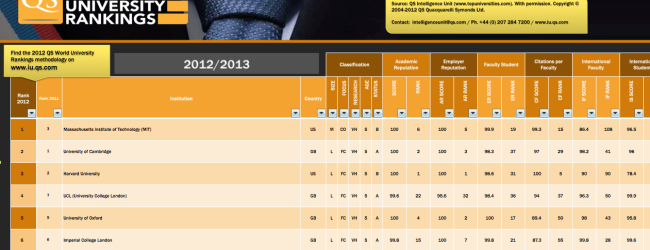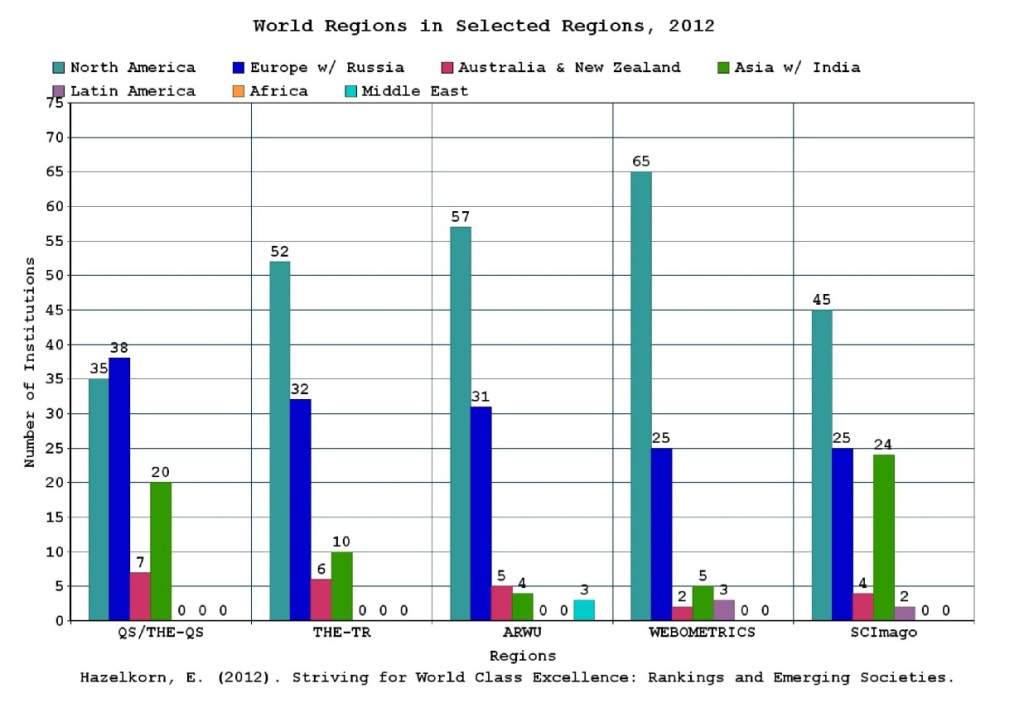
By: Hammad Ahmed Khan
In Malaysia, national newspapers displayed shock and alarm when the University of Malaya’s ‘plummeted in position’ from 180 to 207, lamenting the University’s ‘dropping out of the top 200.’[1] While there are over 15,000 Higher Education Institutions (HEIs) worldwide, there is particular fascination with the top 100, which comprises less than 1% of total institutions globally.[2] A relatively recent phenomenon, rankings consciousness has increased considerably, congruently amplifying its influence on the academia, students, parents, business leaders, and policy-makers.
Rankings can serve an important evaluation purpose. They may also correlate with the drive for increased public transparency and accountability in an opaque system.[3] It incentivizes institutions and academics to build up their research output; in the process, the knowledge-creation positively impacts the larger society, especially in the developing countries, where the correlation between economic and research performance is often desirable.[4]
Not Without Controversy
University rankings have an impact that far outstrips its narrowly purported goal of evaluation. Globalization of higher education may have necessitated such metrics where rankings standardize competition and serve as a signal of quality. Not only are these used for comparative purposes, rankings have also been used by academics and policy-makers for rather narrow prescriptions for improvements. The worst of all, though, is the tendency to ‘play the rankings game’ whereby Universities try to influence those variables that are only considered important for rankings without regards to the actual needs to the institution.
Today, a myriad of publications have established ranking systems and criteria – Times Higher Education, QS World Rankings, SCImago, US News & World Report, and ARWU, to name only a few. In addition, many regions and countries have developed their own systems of ranking; for instance, OIC’s Ranking of Universities of Islamic Universities, Pakistan’s HEC’s Rankings, Malaysia’s SETARA Rating Instrument, United Kingdom’s Research Assessment Exercise (RAE) and others. Clearly, the ranking systems have taken on a fairly prominent position in the overall scheme of things, though not without controversy.
Biases In Rankings
Figure 1 lists the often-referenced ranking publications and the performance of world regions. North America and Western Europe are the clear winners – a super-league of large and well-endowed universities, often with medical schools and in English-speaking countries.[5] While rankings exhibit the excellence of such institutions, they inadvertently expose the bias embedded in the ranking criteria employed. The Academic Ranking of World University (ARWU) heavily relies on bibliometric databases and citation practices, which disproportionally favor research published in English-language international peer-reviewed journals.[6] Although English is the lingua-franca of the academy, other language groups, regardless of their size, suffer. Even when reputation is independently measured through surveys, for QS and THE rankings, for instance, the fact that native English speakers feature highest in these publications affect the rankings.
 Figure 1[7]
Figure 1[7]
Dr. Ellen Hazelkorn, Dean of the Graduate Research School at the Dublin Institute of Technology, Ireland, argues that because detailed familiarity with institutions is quite limited; faculty and peers “tend to rank high those departments of the same type, and with the same emphases, as their own universities or those with whom they are most familiar.”[8] The subjectivity and limitations of such methodologies further institutionalize the biases inherent in these rankings.
Perverse Incentives
While rankings take into account different performance indicators, there is considerable over-reliance on research capacity. Though, knowledge-creation and its dissemination remains one of the fundamental purposes of a university, it is not the only purpose. Prioritizing research at the expense of quality instruction conveniently foregoes one of the primary duties of training and producing competent and responsible citizens. It negatively impacts teaching institutions and actively dis-incentivizes focus on teaching. Moreover, rankings based on a few criteria undermine the diversity of the institutions; thereby, monopolizing and skewing the very definition of a competitive University.
The differences in the global rankings of Muslim universities, in Figure 2 and 3, exemplifies the absence of a universal idea of a complete and competitive university. While Turkey dominates the list in the THE ranking, the absence of Indonesia, Malaysia, and UAE is striking, when universities from these countries generally fare well in the QS Ranking of Muslim universities. The diversity of institutions worldwide naturally purports a pluralistic view of university’s excellence; the ranking systems instill standardization and in turn, competition, among institutions embodying varying and sometimes, incomparable values and educational missions.
Figure 2: Rankings of Universities from the Muslim World in the THE World University Rankings[12]
Figure 3: Rankings of Universities from the Muslim World in the QS Global Rankings [13]
The disproportionate attention to the top of the rankings results in the devaluation of the changing geography of academic activity.[9] The 2013 Shanghai Academic Ranking of World Universities featured five Arab universities, including four from the Saudi Arabia and one from Egypt.[10] Focused improvement against specific indicators, while encouraged by the rankings, could result in strategic, and possibly manipulative, tactics by university administrations. For instance, KAUST, Saudi Arabia’s graduate-level research university of science and technology, has actively sought “top-ranked researchers from different scientific disciplines – all on the Institute for Scientific Information’s (ISI’s) highly cited list,” even on an adjunct basis, in order to boost their position in the rankings.[11] While such strategies could deliver in terms of rankings, they hardly lead to holistic and comprehensive prescriptions to achieve diverse and indigenous excellence in universities.
More Questions Than Answers
Universities in the Muslim world, generally, do not fare well in global university rankings. However, in some instances, such institutions have responded constructively to the challenge, seeking to improve their R&D capacity and output, employing internationally competent faculty, improving student-faculty ratio, and upgrading university facilities. As the developing societies invest in higher education, the question stands as ever relevant: should the Western-centric education model, the one university rankings implicitly propagate, be the definition of competitiveness? Should the process of standardization be prioritized over diversity of educational vision? Does an increase in research output necessarily translate into quality research and instruction? To hand ourselves more question marks about the conventional and ideological wisdom in these matters would be the first step in improving the competitiveness of universities across the Muslim world.
References:
[1]Ching, Aw Tar. “Angst Over University Rankings.” The Journal of Health and Translational Medicine (JUMMEC) 14, no. 1 (2011). http://jummec.um.edu.my/filebank/published_article/2965/JUMMEC 2011 14(1) 01-05.pdf. p. 2
[2]Hazelkorn, E. (2011). Globalization and the Reputation Race in Rankings and the Reshaping of Higher Education: the Battle for World Class Excellence. Palgrave MacMillan. p. 7
[3]Ibid; p. 6
[4]Hazelkorn, E. (2012). Striving for World Class Excellence: Rankings and Emerging Societies. In Araya, D. and Marber , P. Higher Education in the Global Age: Universities, Interconnections and Emerging Societies.Routledge Studies in Emerging Societies Series. p. 1
[5] Ibid; p. 5
[6] Ibid
[7] Ibid; p. 3
[8] Ibid
[9]Hazelkorn, E. (2012); p. 14
[10]“Arab Knowledge Economy Report 2014.” 2014, 1-52. http://www.orientplanet.com/akereport2014.pdf. p. 11
[11]Hazelkorn, E. (2012); p. 9
[12] Times Higher Education World University Rankings 2014-2015; Top-400
[13] “QS World University Rankings 2013.” Top Universities. January 1, 2013.
You must be logged in to post a comment.